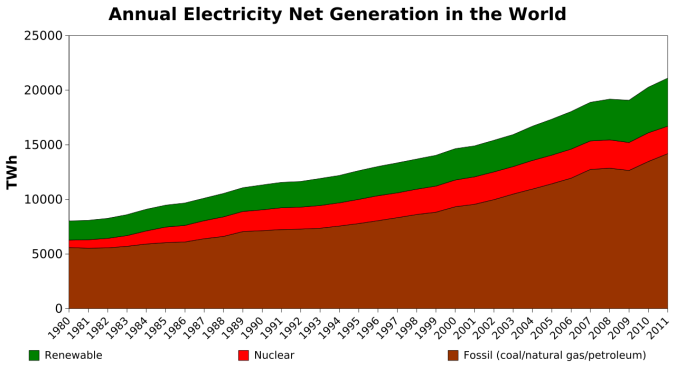As in keeping with the controversy theme I wanted to write my second blog on the controversy that surrounds the energy system in the UK. From what I can tell nuclear energy seems to be a highly considered option but if it’s so good why is there so much controversy involved?
There is very little resistance to the statement that fossil fuels are damaging to the environment and, as they need to undergo millions of years of processes to be created, are on the decline so it’s clear that the energy efforts are needed to be focused elsewhere. But the question is where?
The major factor for the sudden push of renewable energies has been not only the increasing demand for energy in general but also the increasing levels of CO2 in the atmosphere. The Koyoto protocol was introduced by in 1997 to limit this and there are now 192 parties involved.
While it is a nice idea that the world can run purely on renewable sources such as solar and wind energy, in actual fact many think that it’s not possible. In the book ‘Power to the Planet‘ it has been stated that to generate America’s baseload electric power will cost $3 Trillion with nuclear reactors on a few square miles on land. This compared to the $29 Trillion necessary from a mix of solar and wind farms shows that while in the future this may be a sensible option, the technology just isn’t ready yet.

Nuclear Reactors – this seems to be a technology inbetween that of fossil fuels and renewable sources
Firstly I will briefly discuss how the major type of nuclear reactor – the Pressurised Water Reactor (PWR) works. Uranium is split in a reactor core and the resulting heat is used to heat water in a primary chamber. It needs to be kept at a high enough pressure to prevent it from boiling. The steam that is given off by the heated water is then transferred to (and heats) a secondary source of water which once again produces steam, this steam is then used to generate electricity, the water is then cooled and re-used.
If you are interested in learning more about this please do look at the World Nuclear Association website or watch the below video.
Today over a 6th of the UKs energy comes from nuclear energy from 15 operational reactors. And still there is major controversy surrounding the safety of these methods – if they are as unsafe as many suggest should we be worried that we are surrounded by them?
Pros
There are many pros of nuclear energy, these include:
- Incredibly low greenhouse gas emissions – it has been calculated that because of nuclear power the greenhouse gas emission have been decreased by 50%
- Cheap running cost (which obviously leads to low electricity costs) due to the low cost of obtaining uranium (the reactor material)
- Reliability in energy production – much more reliable than say wind power as it can produce energy uninterrupted for up to a year.
- Proficiency – the proficiency is very high compared to fossil fuels, this means that less material can produce more energy… this is why lots of governments are putting a lot of money in to nuclear power sources at the moment
While the uranium used in reactors isn’t renewable other by-products created can be used to run the reactors so in essence there is a renewable element to the process.
Cons
As well as the pros there are obviously cons.
- Firstly, the radioactive waste produced from the plants will need to be disposed of in a safe way which can be expensive.
As well as practical cons there are the safety related cons there are 2 main factors of nuclear energy that people tend to fear.
- Firstly the radiation that is associated with it, the lightening fast particles can enter the body and cause damage to cells and cancer. SCARY right?!
- In actual fact, no, it’s not that scary. If you look at the facts radiation occurs naturally in our environment regardless of if there is a nuclear reactor around or not. The reason why we aren’t all walking around with cancer now is because the actual risk of getting cancer from radiation is extremely low (roughly one chance in 30 million billion).
- The other terrifying thing about nuclear reactors is that apparently they are very likely to have accidents. We’ve all heard of the big accidents – Chernobyl, Fukushima. These big disasters were back in the day when there was much less safety in the systems. We have to remember that, while there will always be a potential for a big disaster, there is actually there are so many safety systems in place today that there is the most minimal risk .
The way the nuclear industry strategises to prevent accidents is that they have multiple back ups for every single system in the reactor. After this it is incredibly unlikely that a reactor meltdown will occur. The World Nuclear Association has stated that in the last 60 years there have only been 3 major meltdowns, one was contained, one involved a large fire that couldn’t be contained and the third led to the release of some radioactivity. The website argues that with the safety practices in place only increasing, nuclear reactor meltdowns are extremely unlikely.
Please also bear in mind that the media will often portray these back up systems as ‘close calls’ when in fact it’s just the normal system working.
After all of this do you think it is worth the risk?
News
It seems that Brexit will also have an impact on the energy production in the UK, please see my next post ‘Brexit – what will it actually mean for UK scientists?’ to find out more about what Brexit will mean for not only UK scientists but for the energy production in this country.